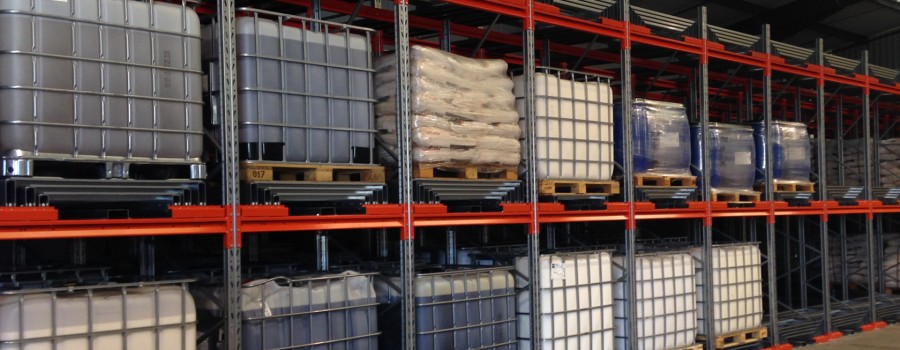
IBCs are a popular and highly efficient storage solution, especially in sectors such as chemicals, engineering and food and drink, however IBC storage systems can be problematic.
IBC storage is not without its challenges both from a space utilisation AND a health and safety point of view.
Whilst they are cube shaped which allows them to be stacked, guidelines published by the Health and Safety Executive state that filled an intermediate bulk container (IBC) should be stacked no more than two high. And this is on the basis that the IBCs have been designed to stack together and the ground conditions are suitable to accommodate the stacking.
This is resulting in more and more companies becoming reluctant to stack IBCs due to the value of the products or hazardous nature of the products being stored. Therefore, many are turning to specialist racking solutions as a way to store their IBCs as it offers many advantages.
- To Increase Storage Capacity or Reduce the Footprint
As we all know, space is at a premium and companies are exploring every opportunity to maximise the profitability per square foot of their premises.
The issues associated with block stacking IBCs prevents companies from maximising the full height of the building and therefore wastes enormous amounts of space.
However, racking enables the IBCs to be stacked up to 4 or 5 high depending on weight and the forklift truck being used.
Take, for example, a company which has 24 IBCs to store. To store these on the ground with no stacking would require 28.8 square metres of floor space. Stacking them 2 high would reduce this to 14.4 square metres.
On the other hand, a single run of IBC pallet racking could safely store 6 IBCs wide by 4 high in only 7.53 square metres of floor space.
Alternatively, if there was the need to increase capacity, IBC Push Back Racking could be used to store 4 IBCs wide by 2 IBCs deep by 4 IBCs high to provide storage capacity for 32 IBCs in just 11.16 square metres of floor space.
- To Improve the Health & Safety in the Area
The impact on health and safety will obviously depend on the number of IBCs being stored and the contents of the IBC. However, if you have reached this part of the whitepaper, the chances are you have a sizable number of IBCs at your facility and their storage has become an issue.
One of the main health & safety issues with simply storing IBCs on the ground level is leakages and the ability to identify them early.
One cause of leaks is the instability of stacked IBCs due to minor differences in shape and specifications – this can mean the IBCs stack at an angle, with them sitting uneven and resulting in a lot of pressure being applied to one corner of the IBC beneath leading to punctures as well as damage to the IBC above.
Another health & safety issue is overcrowding which prevents the early detection of leaks. By the time the leak has been spotted, valuable contents could have been lost or worse, you could be facing a major health and safety incident.
However, an IBC racking solution ensures that the IBCs are stacked correctly and safely regardless of individual differences. This also allows for the early detection of leaks to prevent any major losses of inventory.
- To Reduce the Risk of Fire
IBC containers are extremely vulnerable in the event of a fire with tests showing that an entire inventory of flammable liquid could fail within a period of as little as 10 minutes.
With such a high risk, the storage of IBCs is an area which attracts great interest from the HSE during inspections.
In addition to leaking IBCs as discussed above, some key issues commonly associated with block stacking IBCs which may increase the risk of fire include:
- Dried vegetation or rubbish in storage areas
- Overcrowding leading to storage of liquids outside designated areas
- Accumulation of electrostatic charging
By storing your IBCs on racking and our high density racking solutions you are minimising the risk of these issues.
As per the Health and Safety legislation, a risk assessment is required for areas or buildings that contain any combustible liquids in IBCs or plastic drums with flashpoints up to at least 200oC, which will provide further guidance on the safe storage of IBCs.
- To Comply with Pollution Prevention Control Regulations
With IBCs storing a large quantity of potentially hazardous materials, the physical storage of your IBCs will fall under your obligations under the Pollution Prevention Control Regulations and your Waste Management Licence.
The information contained in these documents together with your internal risk assessment will determine whether bunded storage is required as part of your IBC storage solution.
The guidelines for the use of bunds, or sumps as they are sometimes referred to, is to ensure you have 110% capacity of the volume of your largest container or 25% of the total volume stored.
Our specialist IBC storage solutions can be designed to incorporate storage bunds as well as drip trays to act as a safety measure and prevent potential leaking product from spreading or contaminating other areas.
We also have a range of options and accessories, which can help to detect leaks early.
For more information on our Maxi Cube IBC Pallet Racking, the cost effective alternative to IBC Storage Units, click here
For examples on how we have developed IBC storage solutions for other companies, click here
IBC Storage Systems | IBC Bunded Storage | Thistle Systems IBC Racking Solutions

